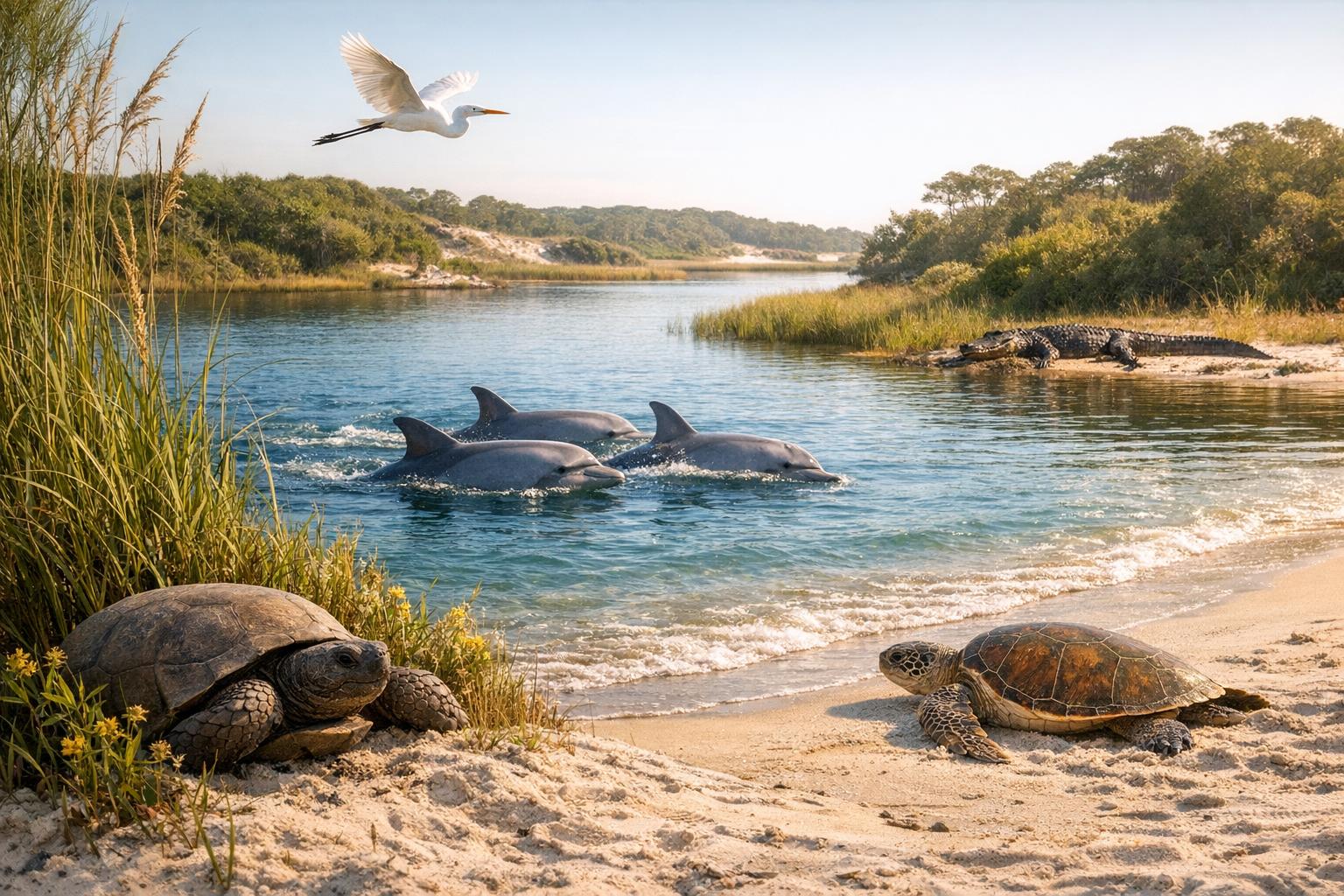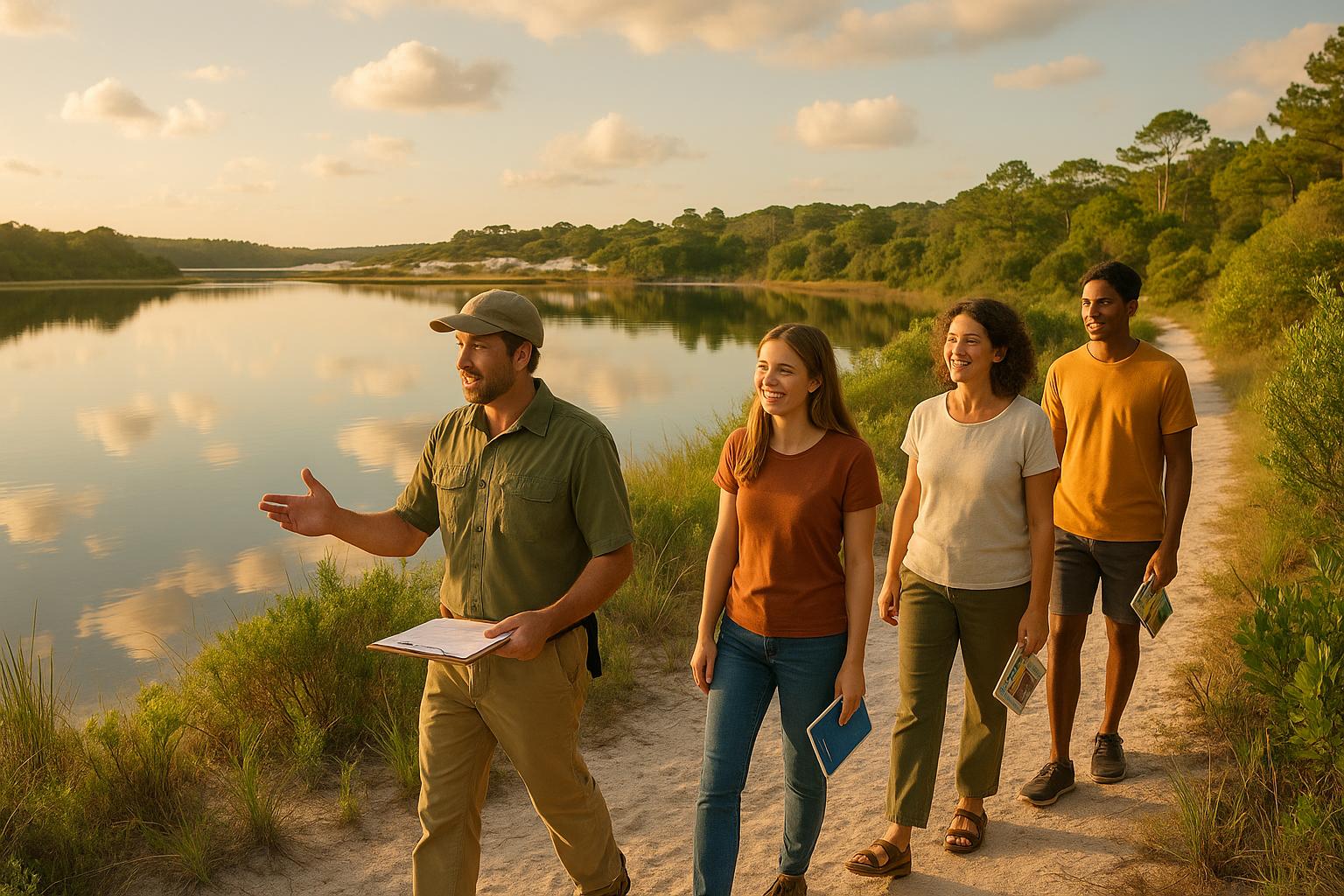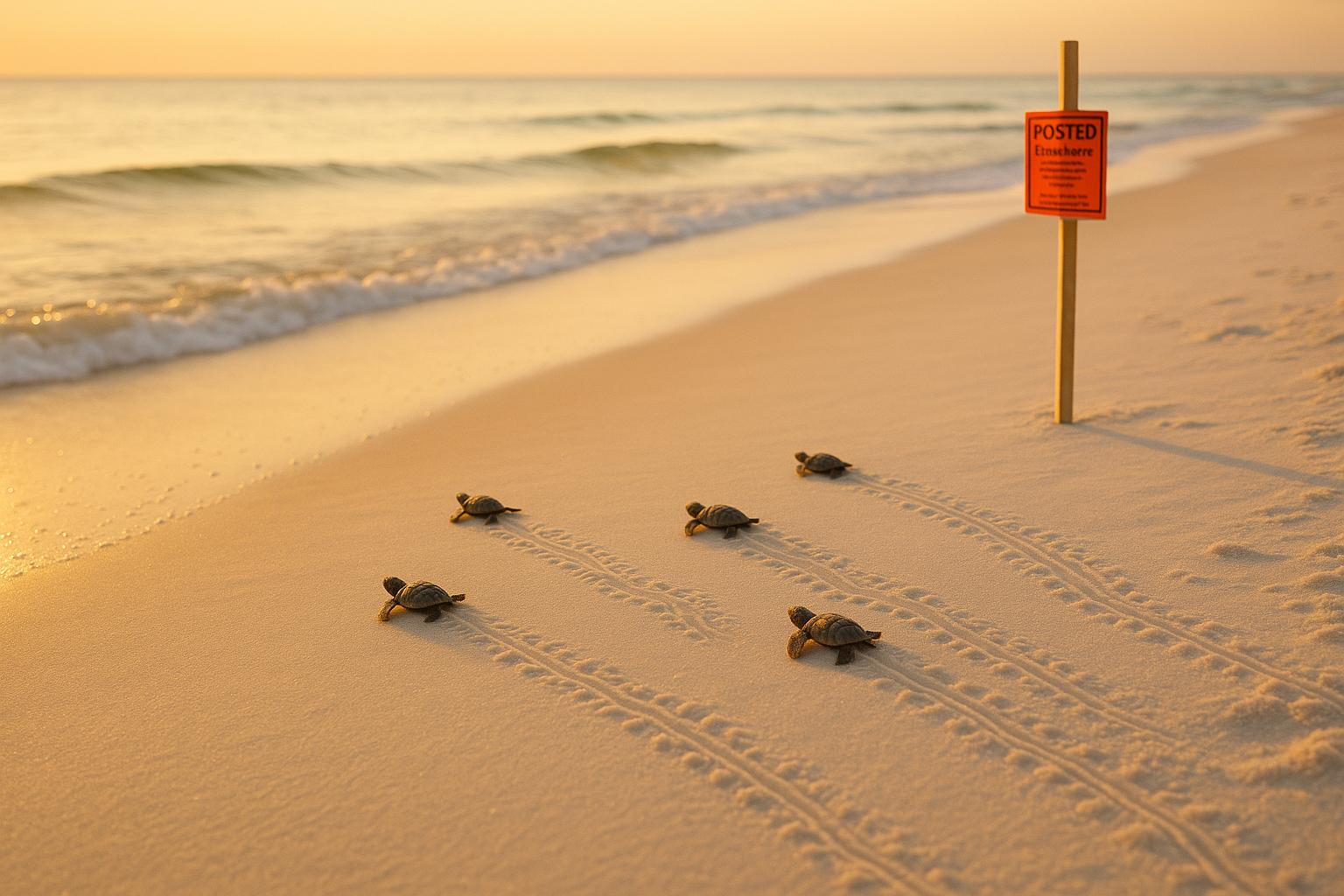If you're planning a dolphin-watching trip along Florida's 30A coastline, here's what you need to know:
- Best Season: April to October is peak dolphin activity, with late spring and early summer offering the largest and most energetic pods.
- Best Time of Day: Mornings (7:00 AM–11:00 AM) provide calm waters, better visibility, and active dolphins. Afternoons and sunsets (2:00 PM–4:00 PM) are a secondary option but can be less predictable.
- Tides & Weather: High tide and calm, clear weather improve your chances of spotting dolphins. Avoid rough seas or murky water for the best experience.
- Year-Round Sightings: Dolphins live in the area year-round, with resident pods always present and seasonal visitors peaking in warmer months.
For the best experience, book a guided tour during high tide in the morning, wear polarized sunglasses, and check local conditions. Whether you're kayaking, paddleboarding, or on a boat, 30A offers unforgettable dolphin-watching opportunities.
Year-Round Dolphin Presence Along 30A
Why Dolphins Live in 30A Waters
The waters along 30A are a haven for bottlenose dolphins, offering warm temperatures and plenty of food all year. The Gulf of Mexico's consistently warm waters and abundant baitfish make this area an ideal home for these marine mammals.
Water temperature plays a big role in why dolphins stick around. The Gulf typically stays above 70°F (21°C) for most of the year, which is perfect for meeting their thermal and nutritional needs.
Another reason dolphins thrive here is the plentiful supply of baitfish, like mullet. The shallow sand flats, protected bays, and estuaries - especially near Choctawhatchee Bay - are brimming with prey. These areas see a peak in fish populations from April to October.
The variety of habitats along 30A also supports different aspects of dolphin life. Shallow bays provide safe spaces for raising calves, while deeper Gulf waters and inlets are prime spots for hunting and socializing. This mix of environments not only sustains their populations but also influences how they interact and form social groups.
Resident Pods vs. Seasonal Visitors
Dolphins along 30A can be divided into two groups: resident pods and seasonal visitors. Resident pods are the core of the local population. These dolphins have established territories and remain in the area year-round, making them a familiar sight. Local tour operators often identify individual dolphins by unique scars, markings, or behaviors, adding a personal touch to the dolphin-watching experience.
Seasonal visitors, on the other hand, bring a temporary boost in numbers and activity, especially during late spring and early summer. Dolphins from other regions - often females in search of mates - join the resident pods during this time, creating larger and more active groups. Because of this, while dolphins can be spotted throughout the year, the liveliest encounters and largest pods are most common between April and October.
This combination of resident dolphins and seasonal visitors ensures that dolphin watching along 30A is always exciting. Whether it's the quieter winter months or the bustling summer season, there’s always an opportunity to catch a glimpse of these fascinating creatures in their natural habitat.
Best Seasons for Dolphin Watching
Seasonal changes along 30A subtly influence dolphin activity, offering unique experiences throughout the year. Depending on the time of year, visitors can enjoy everything from lively displays with larger groups to quieter, more personal moments with these fascinating creatures.
Spring and Early Summer: Active and Energetic Pods
From April to October, dolphin watching along 30A is at its best, with late spring and early summer standing out as prime viewing periods. During these warmer months, the mating season brings female dolphins from other areas to join the resident males, creating larger, more dynamic pods. Morning tours in May often reveal playful interactions - mothers with calves, synchronized leaps, and cooperative hunting behaviors are common sights. These energetic displays make this season a favorite for many dolphin enthusiasts.
Fall and Winter: Quiet and Intimate Encounters
In contrast, fall and winter offer a calmer dolphin-watching experience. Pods are smaller, and the dolphins focus on foraging, leading to more subdued surface activity. These quieter months are ideal for those seeking close, peaceful encounters with these marine mammals. Thanks to the Gulf's consistently warm waters, dolphins remain active year-round, though their behavior and group dynamics shift with the seasons.
For the latest tips and seasonal updates on dolphin watching along 30A, check out sowal.co.
Best Times of Day for Dolphin Sightings
When it comes to dolphin watching along 30A, timing is everything. Beyond seasonal patterns, understanding the best times of day can make your experience even more rewarding.
Dolphins follow predictable feeding and social routines. By aligning your visit with these natural rhythms, you can increase your chances of spotting them.
Morning: The Prime Viewing Window
The best time to catch dolphins in action is between 7:00 AM and 11:00 AM. During these hours, the water is typically calm, boat traffic is light, and visibility is excellent. A pair of polarized sunglasses can help cut through the glare, making it easier to spot dolphins just below the surface.
Local tour guides often highlight morning trips as the most rewarding. You’re likely to witness dolphins feeding, leaping, and swimming in synchronized groups. It’s also common to see mothers with their calves and even cooperative hunting behaviors. The cooler morning temperatures and softer sunlight not only reduce glare but also make for better photography conditions.
Afternoons and Sunsets: A Secondary Option
If mornings aren’t an option, afternoons from 2:00 PM to 4:00 PM or around sunset can still offer good opportunities to see dolphins. The cooler temperatures and softer lighting later in the day often encourage another wave of activity, creating excellent conditions for photography.
However, afternoon outings do come with challenges. Increased boat traffic, warmer temperatures, and choppier waters can make dolphins harder to spot and their behavior less predictable. To improve your chances, bring binoculars or a camera with a zoom lens and check the local tide and weather conditions for calm, clear waters. If you're visiting during a busy season, arriving early can help you secure the best viewing spots.
For up-to-date information on the best viewing times and conditions, visit sowal.co, which provides regular updates on dolphin watching opportunities along the 30A coastline.
sbb-itb-d06eda6
Tidal and Weather Factors to Consider
When it comes to spotting dolphins, tidal patterns and weather conditions play a huge role. These natural elements influence where dolphins feed, how active they are, and how easily you can see them - whether you’re on the shore or out on a boat.
Tidal Patterns and Water Depth
High tide is the sweet spot for dolphin watching along the 30A coastline. When the tide is high, baitfish move closer to shore, and dolphins follow, drawn to the shallower waters to hunt. This makes it more likely for you to see them near beaches, piers, and boats.
The deeper water during high tide also gives dolphins access to sand flats and other shallow areas where they can corner prey like mullet. If you’re lucky, you might even catch them working together in groups using cooperative hunting techniques - something they’re known for in the bays and inlets along 30A.
Timing your outings around high tide is key, but remember, tide times vary daily and by location. During low tide, dolphins tend to retreat to deeper channels and offshore waters, making shore-based sightings less likely. However, boat tours often still have success in these conditions.
In addition to tides, weather and water clarity significantly impact visibility.
Weather and Water Clarity
Calm weather with light winds creates the best conditions for seeing dolphins. When the water is smooth, their dorsal fins and movements are much easier to spot without the distraction of choppy waves. Many guides emphasize that wind conditions can make or break a dolphin-watching experience.
Clear water also enhances visibility, both at the surface and below. Using polarized sunglasses on sunny days can reduce glare, making it easier to spot dolphins swimming just beneath the surface.
On the flip side, strong winds and murky water can make sightings challenging. Stormy or rough conditions not only make dolphins harder to spot but can also make boat trips less comfortable. That said, overcast skies don’t seem to bother the dolphins and can even improve visibility for watchers by reducing glare.
Here’s a quick breakdown of how different weather conditions affect dolphin sightings:
| Weather Condition | Dolphin Visibility | Impact on Viewing |
|---|---|---|
| Calm, clear weather | High | Dorsal fins and movements are easily seen |
| Light winds, smooth seas | Good | Minimal surface interference |
| Overcast but calm | Good | Reduced glare; dolphins remain active |
| Strong winds, choppy seas | Poor | Hard to distinguish dolphins from waves |
| Post-storm conditions | Poor | Murky water reduces underwater visibility |
The best chance to see dolphins combines high tide with calm, clear weather - ideally in the early morning when winds are light, and boat traffic is minimal. Local tour operators often adjust their schedules based on daily tide and weather forecasts to maximize dolphin sightings.
For up-to-date information on tides and weather conditions along the 30A coastline, check out sowal.co. They provide regular updates to help you plan your dolphin-watching adventure.
Conclusion: Making the Most of Your Dolphin Watching Experience
To get the best out of your dolphin-watching trip, plan your visit during the peak season, which runs from April to October. During these months, the warm waters and plentiful baitfish draw in large, active dolphin pods.
Timing your outing can make all the difference. Early mornings, between 7–10 AM, are ideal as dolphins are often feeding in calm waters. If mornings don’t work for you, late afternoons, from 4 PM until sunset, offer another great window with softer light and consistent activity.
For the best chance of sightings, aim to go during high tide and under clear, calm conditions. Don’t forget to bring polarized sunglasses - they’ll cut through glare and make spotting dolphins much easier. These small details can truly elevate your experience.
While dolphins can be seen year-round, booking a tour with knowledgeable local guides adds an extra layer of insight. It’s equally important to respect these wild animals by keeping a safe distance. Opt for eco-friendly tours that prioritize the well-being of marine life.
With some thoughtful preparation, your dolphin-watching adventure along 30A can become a memorable experience, giving you a deeper connection with the stunning natural beauty of the coastline. For up-to-date information on dolphin activity and weather, check out sowal.co.
FAQs
What should I consider when choosing a dolphin-watching tour along 30A?
When planning a dolphin-watching tour along 30A, timing and season play a big role. Dolphins tend to be more active in the early morning or late afternoon, particularly during the warmer months. To make the most of your experience, choose tours that emphasize eco-friendly practices, ensuring the safety of marine life and the surrounding environment.
It's also worth reading reviews to find small group tours or operators with experienced guides who can share fascinating details about dolphin behavior and the area's ecosystem. If you're visiting during peak tourist times, booking ahead is a smart move to guarantee your spot.
How does the weather impact your chances of spotting dolphins on 30A?
Weather greatly influences dolphin activity along the 30A coastline. On calm, sunny days with little to no wind, the smooth water surface makes it much easier to spot dolphins swimming or leaping out of the water. The best times to catch sight of them are usually early mornings and late afternoons, as these cooler periods tend to align with their peak activity.
Rain or storms can make it harder to see dolphins and may even decrease their activity, but don't let cloudy skies stop you. As long as the waters remain relatively calm, there's still a good chance of spotting them. Be sure to check the local weather forecast ahead of time to make the most of your outing!
Where are the best spots along 30A to see dolphins?
Dolphin sightings along the 30A coastline are nothing short of enchanting. While you might catch a glimpse of these playful creatures from many spots, some locations offer a better chance. Coastal gems like Seaside, Grayton Beach, and WaterColor are particularly popular, thanks to their crystal-clear waters that make spotting dolphins easier. For a broader view of the Gulf, piers and elevated beach walkovers are fantastic vantage points.
To increase your chances, head out early in the morning or late in the afternoon when dolphins tend to be more active. Watch the water's surface closely for their iconic fins gliding through the waves, and bring along binoculars to get an even closer look!



